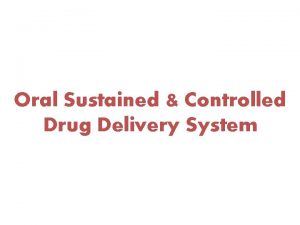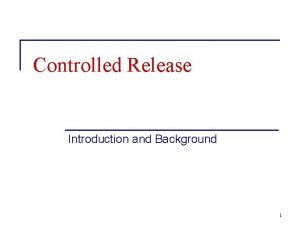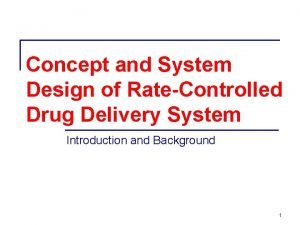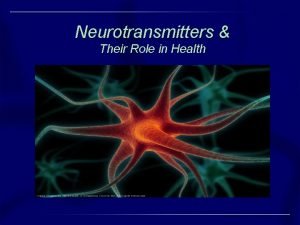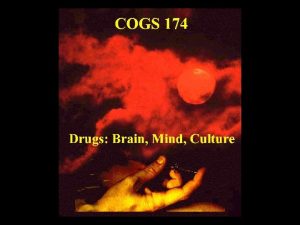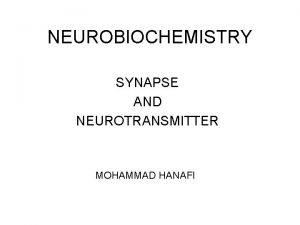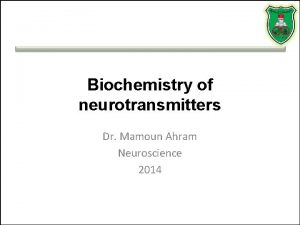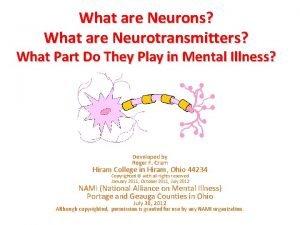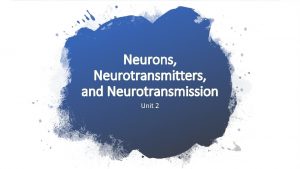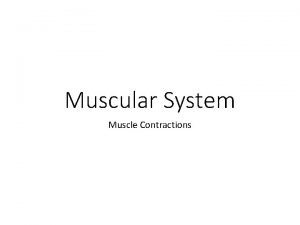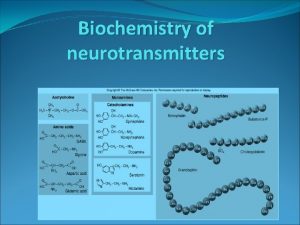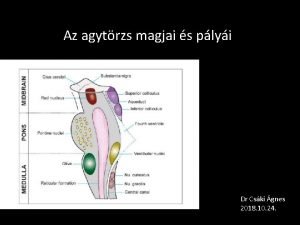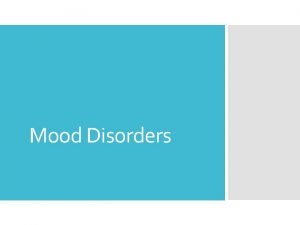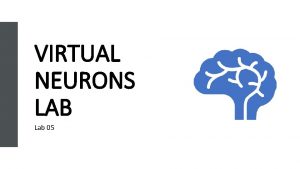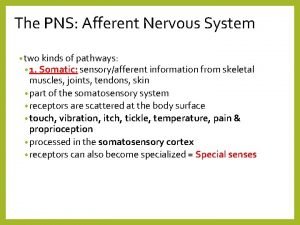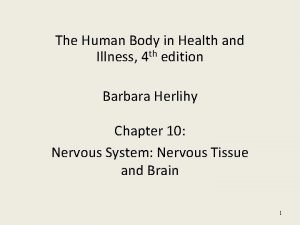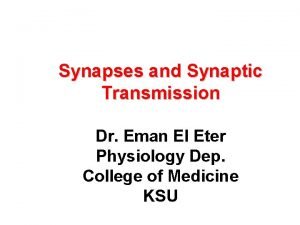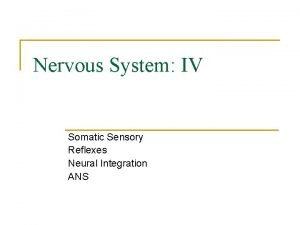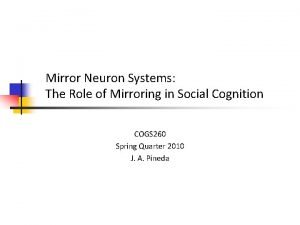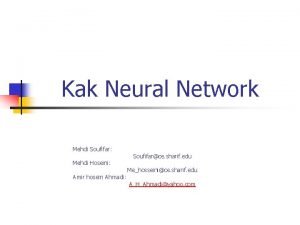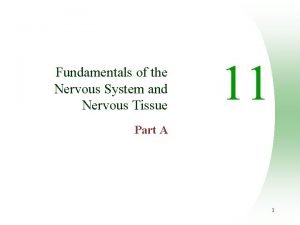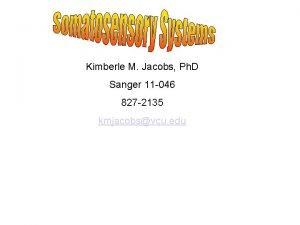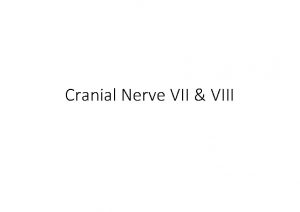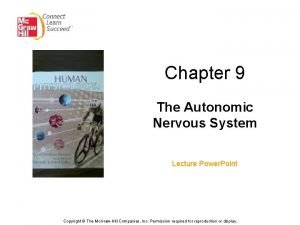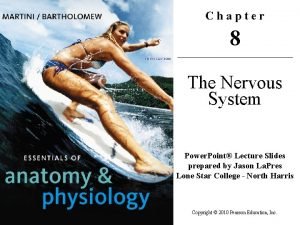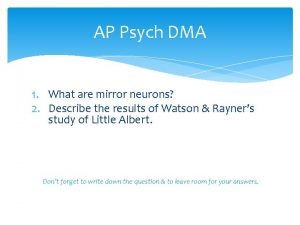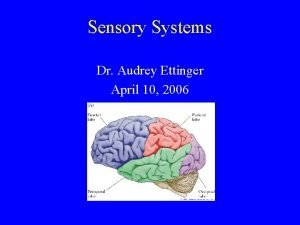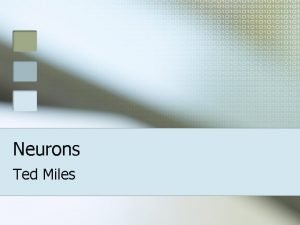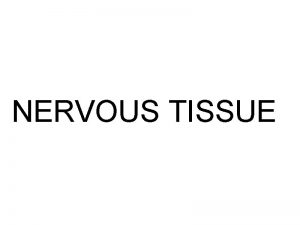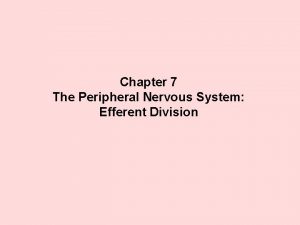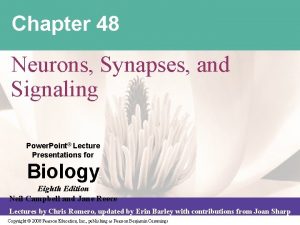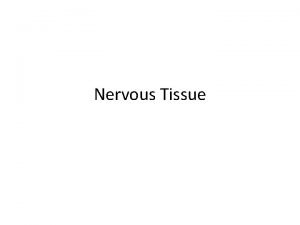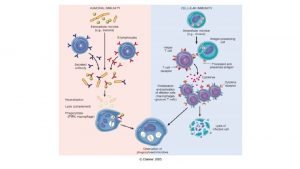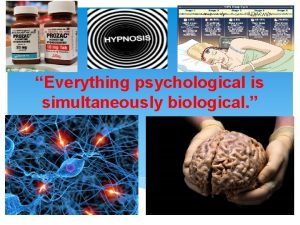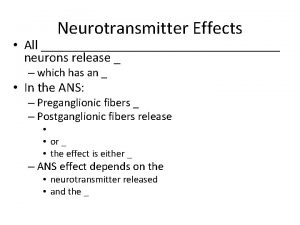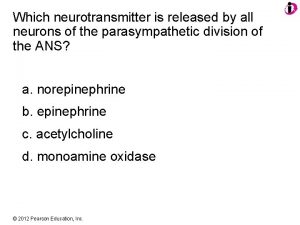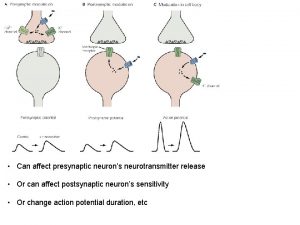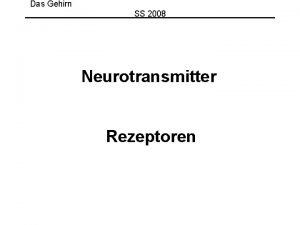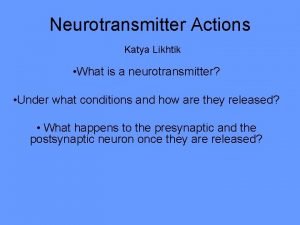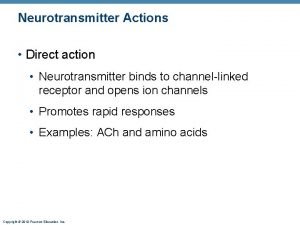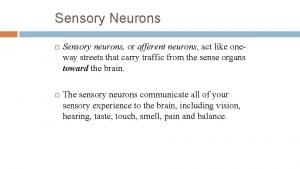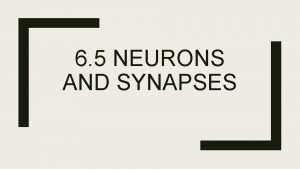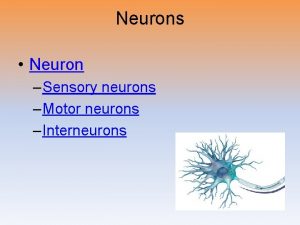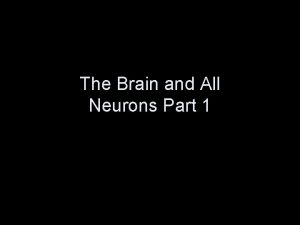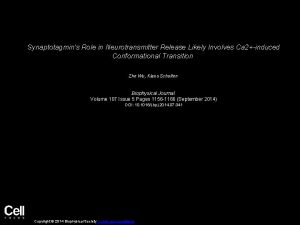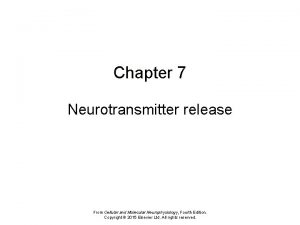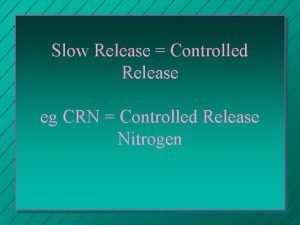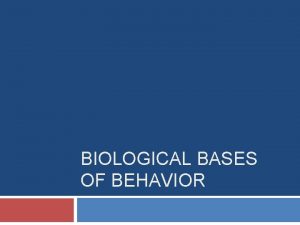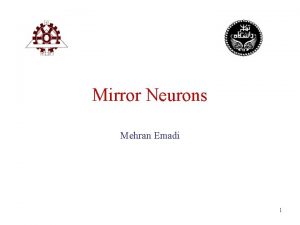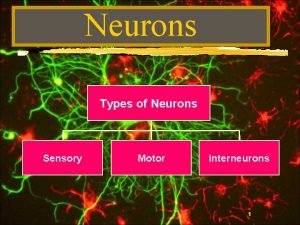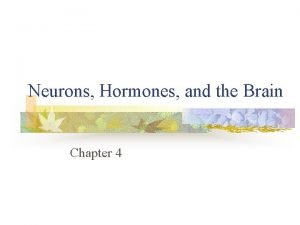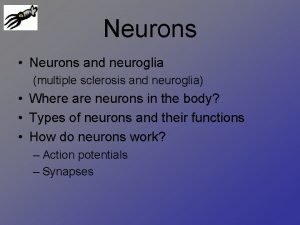Neurotransmitter Effects All neurons release which has an














































- Slides: 46

Neurotransmitter Effects • All __________________ neurons release _ – which has an _ • In the ANS: – Preganglionic fibers _ – Postganglionic fibers release • • or _ • the effect is either _ – ANS effect depends on the • neurotransmitter released • and the _

Comparison of Somatic and Autonomic Systems

Divisions of the ANS • ANS divisions: – • mobilizes the body during _ – • performs ______________________ and conserves body energy • The two divisions provide _

Role of the Parasympathetic Division • Concerned with keeping body energy use low • Involves the _ – • Its activity is illustrated in a person who relaxes after a meal • – Blood pressure, heart rate, and respiratory rates are low – Gastrointestinal tract activity is high – The skin is warm and the pupils are constricted

Role of the Sympathetic Division • The sympathetic division is the _ • Involves _ – exercise, excitement, emergency, and embarrassment

Role of the Sympathetic Division • Promotes adjustments during exercise – blood flow to organs is reduced, _ • Its activity is illustrated by a person who is threatened – Heart rate _______________ and breathing is _ – The skin is cold and sweaty, and the pupils dilate

Anatomy of ANS Division Origin of Fibers Length of Fibers Location of Ganglia Sympathetic Thoracolumbar region Short preganglionic of the spinal cord and long postganglionic Close to the spinal cord Parasympathetic Brain and sacral spinal cord In the visceral effector organs Long preganglionic and short postganglionic

Parasympathetic Division Outflow Cranial Outflow Sacral Outflow Cranial Nerve Ganglion Effector Organ(s) Occulomotor (III) Ciliary Eye Facial (VII) Pterygopalatin Submandibular Salivary, nasal, and lacrimal glands Glossopharyngeal (IX) Otic Parotid salivary glands Vagus (X) Located within the walls of target organs Heart, lungs, and most visceral organs S 2 -S 4 Located within the walls of the target organs Large intestine, urinary bladder, ureters, and reproductive organs

Sympathetic Outflow • Arises from spinal cord segments T 1 through L 2 • Sympathetic neurons form _ • Preganglionic fibers pass through the ___________________ and synapse in the chain (paravertebral) ganglia

Sympathetic Outflow • Fibers from T 5 -L 2 – form _ – synapse with _ • Postganglionic fibers innervate the numerous organs of the body


Sympathetic Trunks and Pathways • The _________________ form part of the sympathetic trunk or chain • Typically there are 23 ganglia – 3 cervical – 11 thoracic – 4 lumbar – 4 sacral – 1 coccygeal

Sympathetic Trunks and Pathways Figure 14. 6

Sympathetic Trunks and Pathways • A preganglionic fiber follows one of three pathways upon entering the paravertebral ganglia 1. Synapse with the _ 2. ____________________ the sympathetic chain to synapse in another chain ganglion 3. Pass through the chain ganglion and _

Pathways with Synapses in Chain Ganglia • Postganglionic axons enter the ventral rami via the _ • These fibers innervate _ • Rami communicantes are associated ________ with the sympathetic division

Pathways to the Head • Preganglionic fibers emerge from T 1 -T 4 and synapse in the superior cervical ganglion • These fibers: – Serve the _ – Stimulate dilator muscles of the _ – Inhibit nasal and salivary glands

Pathways to the Thorax • Preganglionic fibers emerge from T 1 -T 6 and synapse in the _ • Postganglionic fibers emerge from the middle and inferior cervical ganglia and enter nerves C 4 -C 8 • These fibers innervate the __________ via the cardiac plexus, as well as innervating the _

Pathways to the Thorax • Other T 1 -T 6 preganglionic fibers synapse in the nearest chain ganglia • Postganglionic fibers directly serve the – –

Pathways with Synapses in Collateral Ganglia • These fibers (T 5 -L 2) leave the sympathetic chain _ • They form thoracic, lumbar, and sacral _ • Their ganglia include – the superior and inferior mesenterics – the

Pathways to the Abdomen • Sympathetic nerves innervating the abdomen have preganglionic fibers from T 5 -L 2 • They travel through the thoracic splanchnic nerves and synapse at the celiac and superior mesenteric ganglia • Postganglionic fibers serve the

Pathways to the Pelvis • Preganglionic fibers originate from T 10 -L 2 • Most travel via the ___________________ splanchnic nerves to the inferior mesenteric and hypogastric ganglia • Postganglionic fibers serve the distal half of the large intestine, the __________________, and the reproductive organs

Pathways with Synapses in the Adrenal Medulla • Fibers of the thoracic splanchnic nerve pass _ • Upon stimulation, medullary cells secrete ______________________________________ into the blood


Visceral Reflexes • ______________reflexes have the same elements as ________________reflexes • They are always _ • Afferent fibers are found in spinal and autonomic nerves


Referred Pain • Pain stimuli arising from the _________ are _ • This may be due to the fact that visceral pain afferents travel along the same pathways as somatic pain fibers

Neurotransmitters and Receptors • Acetylcholine (ACh) and norepinephrine (NE) are the two major neurotransmitters of the _ • – ACh-releasing fibers – ACh is released by all _____________________ axons and all parasympathetic _ • Adrenergic fibers – _______________________ postganglionic axons that release NE • effects (excitatory/inhibitory) _

Cholinergic Receptors • The _____________of receptors that bind ACh are _ • These are named after drugs that bind to them and mimic _

Nicotinic Receptors • Nicotinic receptors are found on: – ____________________ (somatic targets) – All ganglionic neurons of both sympathetic and parasympathetic divisions – The _________________ cells of the _ • The effect of ACh binding to nicotinic receptors is _

Muscarinic Receptors • Muscarinic receptors occur on all effector cells stimulated by _ • The effect of ACh binding: – Can be either _ – Depends on the _____________________ of the target organ

Adrenergic Receptors • The two types of adrenergic receptors _ • Effects of NE binding to: – receptors is _ • A notable exception – NE binding to receptors of the heart is stimulatory

• Atropine Effects of Drugs – blocks _ • Tricyclic antidepressants – prolong the activity of NE on postsynaptic membranes • Over-the-counter drugs for colds, allergies, and nasal congestion – • Beta-blockers – attach mainly to 1 receptors and _

Interactions of the Autonomic Divisions • Most _____________ organs are innervated by both _ • – increase heart and respiratory rates, and inhibit digestion and elimination • – decrease heart and respiratory rates, and allow for digestion and the discarding of wastes

Sympathetic Tone • The sympathetic division ___________________ and keeps the blood vessels in a continual state of partial constriction • This sympathetic tone (vasomotor tone): – Constricts blood vessels and causes blood pressure to rise as needed – Prompts vessels to ____________ if blood pressure is to be _

Parasympathetic Tone • Parasympathetic tone: – – Dictates normal activity levels of the digestive and urinary systems • The sympathetic division can override these effects during times _ • Drugs that block parasympathetic responses increase heart rate and block fecal and urinary retention

Cooperative Effects • ANS _______________ is best seen in control of the external genitalia • _________________ fibers cause _______________and are responsible for erection of the penis and clitoris • ________________ fibers cause _________________ in males and reflex peristalsis in females

Unique Roles of the Sympathetic Division • Regulates many functions not subject to _ • These include the activity of the – – sweat glands – arrector pili muscles – – most blood vessels

Unique Roles of the Sympathetic Division • The sympathetic division controls: – Thermoregulatory responses to _ – Release of _ – Metabolic effects

Thermoregulatory Responses to Heat • Applying heat to the skin causes __________________ of blood vessels • Systemic body temperature elevation results in widespread dilation of blood vessels • This dilation brings warm blood to the surface – • When temperature falls, blood vessels constrict and blood is retained in deeper vital organs

Release of Renin from the Kidneys • Sympathetic impulses activate the kidneys _ • Renin is an enzyme that _

Metabolic Effects • The sympathetic division promotes metabolic effects _ – Increases the metabolic rate of body cells – Raises _ – Mobilizes _ – Stimulates the reticular activating system (RAS) of the brain, increasing mental alertness

Localized Versus Diffuse Effects • The parasympathetic division exerts _ • The sympathetic division exerts _

Effects of Sympathetic Activation • Sympathetic activation is long-lasting because NE: – Is __________________ more slowly than _ – Is an indirectly acting neurotransmitter, using a _ – And epinephrine are released into the blood and _

Levels of ANS Control • The hypothalamus is the main __________________ center of ANS activity • Subconscious cerebral input via limbic lobe connections influences hypothalamic function • Other controls come from the ________________ , the reticular formation, and the _

Levels of ANS Control

Hypothalamic Control • Centers of the hypothalamus control: – – Body temperature, ____________________, and endocrine activity – ____________________ (rage, pleasure) and biological drives (hunger, thirst, sex) – Reactions to ______________ and the “fight-or-flight” system
 Time release medication
Time release medication Nocoderm
Nocoderm Extended release vs sustained release
Extended release vs sustained release Whats a neurotransmitter
Whats a neurotransmitter Serotonin excitatory
Serotonin excitatory Life cycle of neurotransmitter
Life cycle of neurotransmitter Glutamate role
Glutamate role Small-molecule neurotransmitters
Small-molecule neurotransmitters Cross bridge cycle
Cross bridge cycle Neurotransmitter
Neurotransmitter Neurotransmitter
Neurotransmitter Myosin and actin
Myosin and actin Where are neurotransmitters produced
Where are neurotransmitters produced Neurotransmitter
Neurotransmitter Tr corticospinalis
Tr corticospinalis Neurotransmitter in somatic nervous system
Neurotransmitter in somatic nervous system Kandel
Kandel Mood...
Mood... Name
Name Virtual neurons
Virtual neurons Proprioceptors
Proprioceptors Polarized vs depolarized neurons
Polarized vs depolarized neurons Via optica
Via optica Dr eter
Dr eter Input neurons
Input neurons Somatic motor cortex
Somatic motor cortex Inverse stretch reflex
Inverse stretch reflex Location of sensory neurons
Location of sensory neurons Mirror neuron
Mirror neuron Input neurons
Input neurons Label the different types of neuronal pools in the figure.
Label the different types of neuronal pools in the figure. Extrapyramidal tract names
Extrapyramidal tract names Fourth order neurons
Fourth order neurons Vestibulocochlear nerve.
Vestibulocochlear nerve. Preganglionic fibres
Preganglionic fibres Figure 8-2 neurons and neuroglia
Figure 8-2 neurons and neuroglia Mirror neurons ap psych
Mirror neurons ap psych Characteristics of sensory neurons
Characteristics of sensory neurons What are neurons composed of
What are neurons composed of Nervous system communication
Nervous system communication Efferent motor neurons
Efferent motor neurons Chapter 48 neurons synapses and signaling
Chapter 48 neurons synapses and signaling Unipolar neurons are found in
Unipolar neurons are found in Neuronal pools are collections of
Neuronal pools are collections of Information flow through neurons
Information flow through neurons How neurons communicate
How neurons communicate Exteroceptors
Exteroceptors
